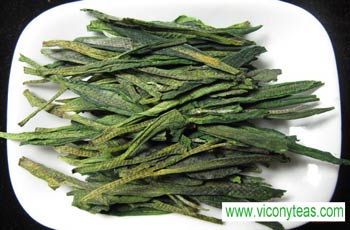Is the Taiping Houkui totally handmade? How can we tell the Taiping Houkui is handmade or not by its appearance? What is Nie Jian Houkui and what is Bu Jian Houkui? These are the frequently asked questions. Here we will elaborate on how to tell them.
Taiping Houkui can be mainly divided into three kinds by its production methods. They are Nie Jian, Li Jian and Bu Jian respectively. Now, Nie Jian and Bu Jian Houkui are the commonly found ones on the market. Among them, Nie Jian is almost entirely handmade. Five people can only make 500grams finished tea for more than 1 hour so for the same raw material, if it is made into Nie Jian, the price would be the highest. Li Jian is the almost handmade Taiping Houkui. Machine is usually used in the procedure of Sha Qing (fixation) for Li Jian Houkui.
Bu Jian Houkui is partly hand made. Machine is not only used in the procedure of Sha Qing(fixation) but also in Li Tiao (Shaping) so Bu Jian Houkui appears to be neater and thinner in appearance than Li Jian and Nie Jian and people can easily tell it apart. Bu Jian Houkui is much lower in price and inferior in taste and flavor than its counterparts of Nie Jian and Li Jian if made of the same fresh tealeaves while considering the wide price gap, people may think Bu Jian is a good choice.
Bu Jian Houkui is partly hand made. Machine is not only used in the procedure of Sha Qing(fixation) but also in Li Tiao (Shaping) so Bu Jian Houkui appears to be neater and thinner in appearance than Li Jian and Nie Jian and people can easily tell it apart. Bu Jian Houkui is much lower in price and inferior in taste and flavor than its counterparts of Nie Jian and Li Jian if made of the same fresh tealeaves while considering the wide price gap, people may think Bu Jian is a good choice.
Except the three main kinds, sometimes we can find another kind called as Kui Jian on the market. There is no strict requirement for the length, size of the fresh tealeaves to produce Kui Jian so the finished Kui Jian doesn't appears to be as uniform as Nie Jian or Bu Jian. It is usually produced by tea farmers in a casual way sometimes even with picked tealeaves from the remote abandoned tea gardens while you may find very good Kui Jian Houkui but unfortunately it is an unpredictable thing.
Some people may think Bu Jian Houkui is light in taste. That is because Bu Jian Houkui is thin and has a large size so people may throw less amount of tea when brewing it, causing it light in taste.
Quite a number of vendors would show Nie Jian or Li Jian Houkui to you and acclaim they are authentic Taiping Houkui. Is it true? No, Nie Jian, Li Jian or Bu Jian is just defined by its production methods but the authenticity is mainly decided by its producing area. Hou Kui produced from Hou Keng, the core producing area, is mostly Nie Jian but there are still a great deal of Bu Jian Houkui produced in Xinming Township, the original place of Taiping Houkui.
We can see grid marks on the leaves of Nie Jian and Li Jian Houkui. Some vendors take advantage of it and said they are the proof of hand-made authentic Houkui. It is another misleading statement. The grid marks were formed during the procedure of baking. Usually, if there are the grid marks existing, you can only say they are probably Nie Jian or Li Jian Houkui but as we said before, they can't prove its authenticity.
Another common misconception is that Nie Jian is necessarily much expensive than BuJian. It isn't. The main factors deciding the price include
producing area, harvesting time and production method so you can't compare the tea
price by only considering one or two factors。
Nie Jian Houkui(捏尖猴魁):
Li Jian Houkui(理尖猴魁):
Bu Jian Houkui(布尖猴魁):
Kui Jian(魁尖):
Related Posts of Taiping Houkui:







No comments:
Post a Comment